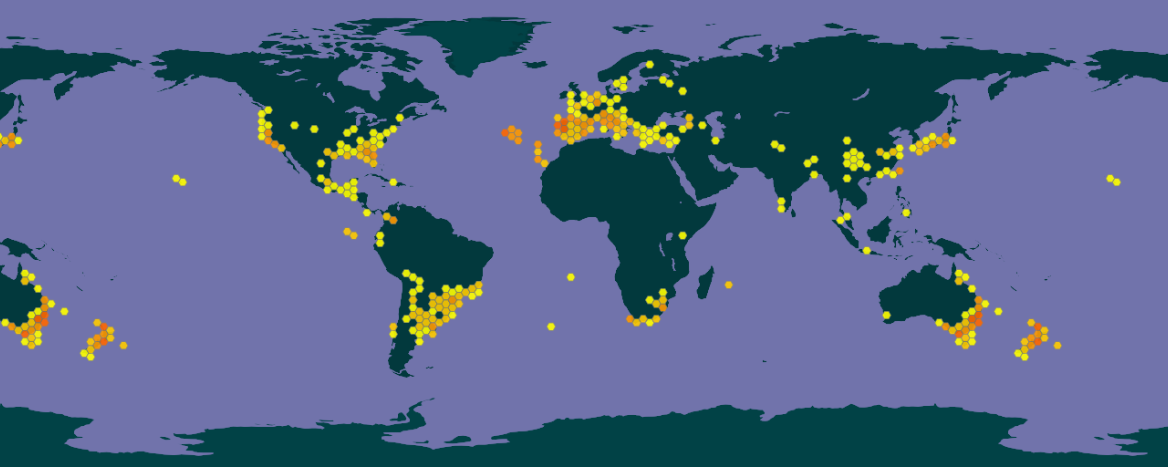 |
Small-leaf spiderwort | Status LU: n/a. 1st record: n/a |
 |
Status Eur.: partly naturalised | |
 |
Éphémère de Rio | RA: ISEIA: n/a Harmonia+: n/a |
 |
Rio-Dreimasterblume | Wikipedia: |
 |
Back to the list of neophytes |
Contents
Report the species
→ Report Tradescantia fluminensis to the National Museum of Natural History.
Brief description
Tradescantia fluminensis Vell. is a species of spiderwort native to South America. It is a perennial groundcover that spreads along the ground with soft, hairless stems and leaves. Tradescantia fluminensis is grown as a garden plant or houseplant in many places. The plant requires a moist soil to develop well and tolerates heavy shade. It is retarded by cold climates, especially where there is frost or snow. The plant is considered poisonous, but it is controversial as to how strong its poisonous properties are. Tradescantia fluminensis is considered an invasive species, noxious weed in many places. Its invasive qualities result from a combination of attributes. Forming a dense mat underneath forest tree cover, facilitated by a remarkable shade tolerance, it smothers ground-level plants and prevents the natural regeneration of taller species. If left unchecked, it can lead to the destruction of native forests. In areas where the plant is a pest. mechanical control is an arduous task since every single scrap of the weed has to be removed or it will regrow. In less prolific areas, manual removal is less difficult as the plant roots come up easily, and an initial clearance can be accomplished by raking the area. To achieve complete control, repeated efforts every few months, coupled with regular monitoring for invasions from surrounding areas, are essential (Wikipedia contributors 2024).
In Europe, the plant is widespread in Italy and Portugal and has been recorded in Spain, Croatia, Greece, Cyprus, Turkey, Romania, Malta, France, Belgium and the UK. In Germany and Switzerland, there are only a few documented cases where the plant has spread into the wild and invaded natural vegetation. (CABI 2019, OpenAI 2024).
Status and distribution in Luxembourg
Records of Tradescantia fluminensis Vell. in Luxembourg. Data source: Recorder-Lux, iNaturalist & GBIF, 2025-12-21.
In Luxembourg, the plant has not been observed in the wild yet.
Risk assessment
ISEIA protocol
Not assessed yet.
Harmonia+ protocol
Not assessed yet.
Worldwide distribution

Source: GBIF 2024 (https://www.gbif.org/species/2765156)
Bibliography
- CABI, 2019. Tradescantia fluminensis. In: Invasive Species Compendium. Wallingford, UK: CAB International. URL: www.cabi.org/isc [accessed 2024-10-09]
- OpenAI, 2024. “Response from ChatGPT.” October 9, 2024. https://chat.openai.com.
- Verloove F. (2024) Tradescantia fluminensis. On: Manual of the Alien Plants of Belgium. Botanic Garden Meise, Belgium. At: alienplantsbelgium.be [accessed 09/10/2024]
- Wikipedia contributors, 2024. ‘Tradescantia fluminensis’, Wikipedia, The Free Encyclopedia, 30 September 2024, 10:26 UTC, <https://en.wikipedia.org/wiki/Tradescantia_fluminensis> [accessed 2024-10-09]
Suggested citation of this webpage
Ries, C., M. Pfeiffenschneider & Y. Krippel (Eds.), 2025. Tradescantia fluminensis Vell. In: neobiota.lu - Invasive Alien Species in Luxembourg. National Museum of Natural History, Luxembourg. URL: https://neobiota.lu/tradescantia-fluminensis-vell/ [Accessed 2025-12-21].
Page content last updated on 2024-10-09.

